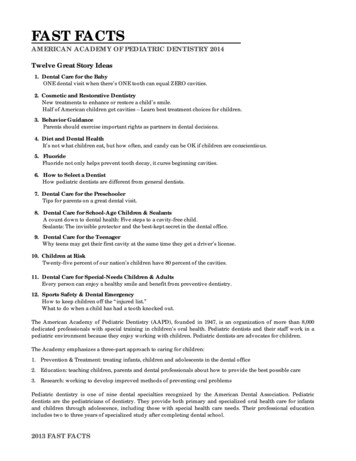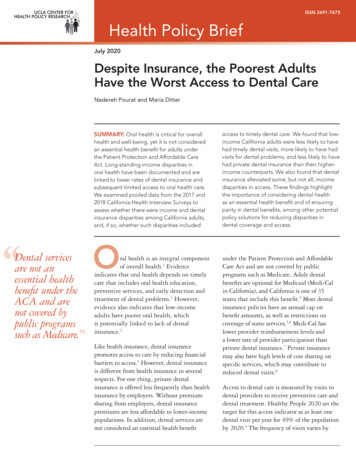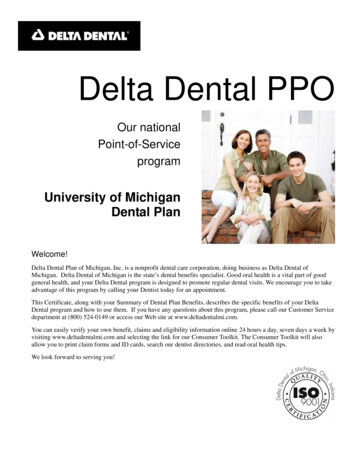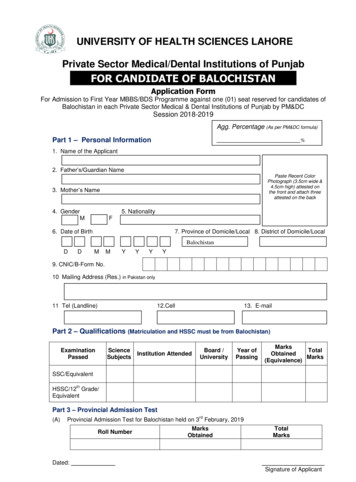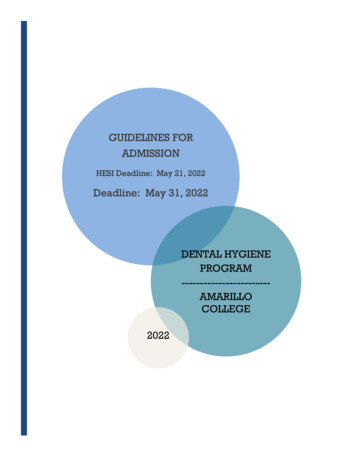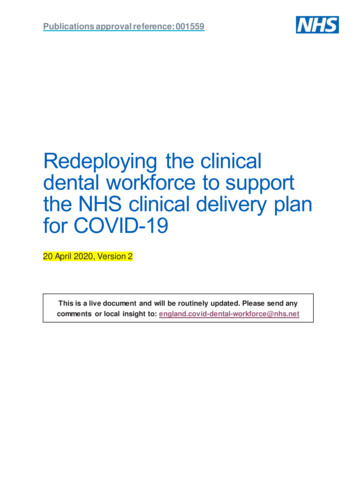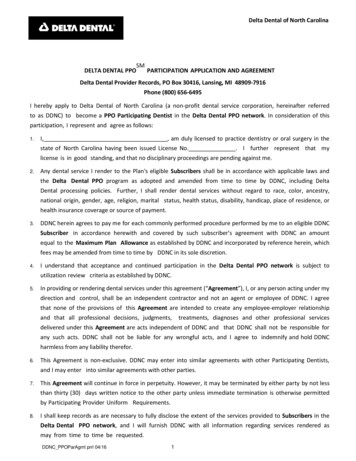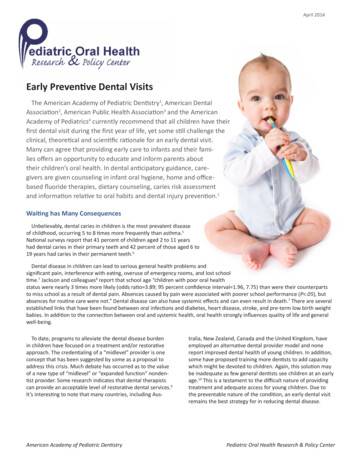
Transcription
April 2014Early Preventive Dental VisitsThe American Academy of Pediatric Dentistry1, American DentalAssociation2, American Public Health Association3 and the AmericanAcademy of Pediatrics4 currently recommend that all children have theirfirst dental visit during the first year of life, yet some still challenge theclinical, theoretical and scientific rationale for an early dental visit.Many can agree that providing early care to infants and their families offers an opportunity to educate and inform parents abouttheir children’s oral health. In dental anticipatory guidance, caregivers are given counseling in infant oral hygiene, home and officebased fluoride therapies, dietary counseling, caries risk assessmentand information relative to oral habits and dental injury prevention.1Waiting has Many ConsequencesUnbelievably, dental caries in children is the most prevalent diseaseof childhood, occurring 5 to 8 times more frequently than asthma.5National surveys report that 41 percent of children aged 2 to 11 yearshad dental caries in their primary teeth and 42 percent of those aged 6 to19 years had caries in their permanent teeth.6Dental disease in children can lead to serious general health problems andsignificant pain, interference with eating, overuse of emergency rooms, and lost schooltime.7 Jackson and colleagues8 report that school age “children with poor oral healthstatus were nearly 3 times more likely (odds ratio 3.89; 95 percent confidence interval 1.96, 7.75) than were their counterpartsto miss school as a result of dental pain. Absences caused by pain were associated with poorer school performance (P .05), butabsences for routine care were not.” Dental disease can also have systemic effects and can even result in death.7 There are severalestablished links that have been found between oral infections and diabetes, heart disease, stroke, and pre-term low birth weightbabies. In addition to the connection between oral and systemic health, oral health strongly influences quality of life and generalwell-being.To date, programs to alleviate the dental disease burdenin children have focused on a treatment and/or restorativeapproach. The credentialing of a “midlevel” provider is oneconcept that has been suggested by some as a proposal toaddress this crisis. Much debate has occurred as to the valueof a new type of “midlevel” or “expanded function” nondentist provider. Some research indicates that dental therapistscan provide an acceptable level of restorative dental services.9It’s interesting to note that many countries, including Aus-American Academy of Pediatric Dentistrytralia, New Zealand, Canada and the United Kingdom, haveemployed an alternative dental provider model and nonereport improved dental health of young children. In addition,some have proposed training more dentists to add capacitywhich might be devoted to children. Again, this solution maybe inadequate as few general dentists see children at an earlyage.10 This is a testament to the difficult nature of providingtreatment and adequate access for young children. Due tothe preventable nature of the condition, an early dental visitremains the best strategy for in reducing dental disease.Pediatric Oral Health Research & Policy Center
Rationale for Early Preventive Visits in MedicineIn medicine there are numerous examples of the cost effectiveness of early prevention. Folic acid supplementation beginning before conception and continued for thefirst 10-12 weeks can result in dramatically fewer neural tube defects among infantsand the cost reductions are immense.11 Prenatal care also is accepted as an effective tool to reduce health care costs and improve both maternal and infant health.Mothers who do not receive prenatal care are almost three times as likely to have alow-birth-weight infant as mothers who did.12 A few studies have shown that for everydollar spent on prenatal care, the health care system saves between 2.57 and 3.38on the medical cost of care to low-birth-weight babies.13, 14 Like well-child medical vis-Rates of Dental and Otitis Media20.015.010.05.01,000Rates Per 1,00025.00.0199719981999200020012002YearOtitis Media VisitsDental VisitsFigure 1: Trends in Operating Room Visits for Dental Treatment versus Treatmentfor Otitis Media During 1997-2002its, one of the cornerstones of the infantdental visit is to prepare parents andcaregivers for future age-specific needsand dental milestones. With early andtimely intervention, it may be possibleto reduce or eliminate future dental caries which in turn should reduce dentallyrelated costs.Rationale for the Cost-Effectiveness of Early Dental InterventionEarly dental visits should be expectedto reduce the child’s future dental riskleading to improved oral health andreduced oral health costs. Becauseuntreated dental disease increases inseverity and necessitates more extensive and costly treatment secondary topostponing care, timely intervention hasgreat potential to reduce overall costsassociated with dental treatment in preschool children. White and colleaguesexamined the use of the operating roomand compared visits for two conditions:otitis media and dental caries in otherwise healthy children under age 5.15 Thenumber of otitis media visits per 1,000children decreased slightly during afive-year period. In comparison, the rateof dental visits increased by 43 percent(Figure 1).
Effectiveness of EarlyDental VisitsAge of ChildFigure 2: Average dental costs for children aged 1-5 from 1992-1997Age of ChildFigure 3: Average related cost for dental treatment in the hospital/operating roomsetting for children aged 1-5Reports that examined Iowa Medicaid children less thanage 6 treated for early childhood caries in the hospital orambulatory care setting indicate that less than five percentof those receiving dental care consumed 25 to 45 percent ofthe dental resources.16 Another similar study from Washington State concluded that 19 percent of their pediatric dentalemergencies were related to early childhood caries and ofthose over half were children 3.5 years or younger.17 Thesestudies emphasize that early prevention can translate intosignificant cost-savings for dental care, especially for thosefamilies at or below the poverty level where caries rates aredramatically higher in children 3 years and younger.Several studies have examined theeffectiveness of early dental visits. Theseminal study was conducted by Savageand colleagues18 who examined theeffects of early preventive dental visitson subsequent utilization and costs ofdental services among preschool-agedchildren. Children who had their firstpreventive dental visit by age 1 weremore likely to have subsequent preventive visits but were not more likely tohave subsequent restorative or emergency visits. Additionally, the age at thefirst preventive dental visit had a significant positive effect on dentally-relatedexpenditures, with the average dentallyrelated costs being less for childrenwho received earlier preventive care.The average dentally-related costs forchildren with the first dental visit at age1 was 300 less than those that waiteduntil age 3. Two subsequent studies ofMedicaid children in Wisconsin19 andMichigan20 failed to find a relationshipbetween an early dentist visit and totaldental costs. Unlike the study conductedby Savage and colleagues18 , both ofthese investigations did not includehospital, emergency room and othermedical related costs associated withtreatment of dental disease in youngchildren. A disproportionate share ofcosts for dental treatment of childrenunder age 5 is for emergency room orhospital visits that are realized in medical costs (Figures 2 and 3).A study from Alabama21 examined theeffectiveness of preventive dental visitsin reducing nonpreventive dental visitsand expenditures. They concluded that“preventive dental visits can reduce subsequent nonpreventive visits and expenditures for childrencontinuously enrolled in CHIP. However, they may not reduceoverall program costs”. These results are not surprising giventhat the investigation examined children in two cohorts (children aged 8 years and those aged 8 years). The inclusionof older children with those in the preschool age population(children ages 6) may skew findings as a higher proportion ofyounger children need to be seen in ambulatory or hospitalsettings for care.
The American Academy of Pediatric Dentistry (AAPD) is the recognized authority on children’s oral health. As advocates for children’s oral health, the AAPD promotes evidence-based policies and clinical guidelines; educates and informs policymakers, parentsand guardians, and other health care professionals; fosters research; and provides continuing professional education for pediatricdentists and general dentists who treat children. Founded in 1947, the AAPD is a not-for-profit professional membership associationrepresenting the specialty of pediatric dentistry. Its 9,300 members provide primary care and comprehensive dental specialty treatments for infants, children, adolescents and individuals with special health care needs. For further information, please visit the AAPDwebsite at http://www.aapd.org or the AAPD’s consumer website at http://www.mychildrensteeth.org.The Pediatric Oral Health Research and Policy Center (POHRPC) exists to inform and advance research and policy developmentthat will promote optimal children’s oral health and care. To fulfill this mission, the POHRPC conducts and reports oral health policyresearch that advances children’s oral health issues and supports AAPD public policy and public relations initiatives at the national,state, local, and international levels with legislatures, government agencies, professional associations, and other non-governmentalorganizations.For more information about the AAPD Pediatric Oral Health Research and Policy Center, please access our website at http://www.aapd.org/policycenter/.This report was authored by Jessica Lee, D.D.S.
Another study conducted in North Carolina comparedoutcomes for Medicaid children who have a preventive visitbefore the age of 18 months with those who have a visit atage 18–42 months.22 This investigation defined preventivevisits as primary, secondary and tertiary. Primary prevention isdefined as true prevention, preventing disease from the start.Secondary prevention refers to detecting disease early andarresting progression. Tertiary prevention is focused on reducing morbidity and complications of a condition. For purposesof their analysis, a primary preventive visit was defined as anearly dental visit for preventive services that had no treatmenton the day of visit or for 3 months. A secondary preventive visitwas defined as an early dental visit for preventive services thatwas followed by no more than two restorative treatment procedures. A secondary preventive visit was defined as an earlydental visit for preventive services that was followed by morethan two treatment procedures. They found that children whohad a primary or secondary preventive visit by age 18 monthshad no difference in subsequent dental outcomes comparedwith children in older age categories, but those children whohad a tertiary preventive visit by age 18 months had lowerrates of subsequent treatment and lower treatment expenditures compared with children in older age categories. Childrenwho benefited most from an early preventive visit were presenting with dental needs already by age 18 months. Evidenceincreasingly suggests that to be successful in preventing dentaldisease, we must begin preventive interventions in infancy. Ifappropriate measures are applied sufficiently early, it may bepossible to raise a cavity-free child. The medical communityhas promoted the concept of a medical home to improve families’ care utilization. Establishment of the Dental Home earlyin the child’s life can introduce children and their families toprevention and early intervention prior to the development ofdental problems.23,24SummaryTreatment of dental disease in young children can be costlyand have devastating effects young children and their families.There is good clinical, theoretical, and scientific evidence thatearly dental visits can be effective at improving health outcomes and reducing dentally related costs. The study conducted by Savage and colleagues followed children for 5 years, andone can only hypothesize about what the cost-savings wouldbe if this cohort were followed for 10 or 20 more years. If thetrend of using more preventive services and less restorative oremergency services holds or increases, the cost-impact wouldbe dramatic with savings in the millions of dollars. For all ofthese reasons, the American Academy of Pediatric Dentistry(AAPD), American Dental Association (ADA) and the AmericanAcademy of Pediatrics all recommend a dental visit for childrenby age one.
References1.American Academy of Pediatric Dentistry. Infant Oral Health.Pediatr Dent 2000;22:82.2.American Dental Association. ADA Statement on Early Childhood Caries; 2004.3.American Association of Public Health Dentistry. First OralHealth Assessment Policy; 2004.4.American Academy of Pediatrics. Recommendations for Preventive Pediatric Health Care. Pediatrics 2000;105:645.5.Oral Health in America: A Report of the Surgeon General.Rockville, MD: U.S. Department of Health and Human Services,National Institute of Dental and Craniofacial Research, National Institutes of Health; 2000.6.Beltran-Aguilar ED, Barker LK, Canto MT, et al. Surveillancefor dental caries, dental sealants, tooth retention, edentulism, and enamel fluorosis. MMWR Surveillance Summaries.2005;54(3):1-44.7.8.9.Edelstein BL, Maiorini E, Casamassimo PS, and ThikkurissyS, Beyond the dmft: The Human and Economic Cost of EarlyChildhood Caries J Am Dent Assoc 2009;140(6):650-657Jackson SL, Vann WF Jr., Pahel BT, Kotch JB, Lee JY. The Impact of Poor Oral Health on Children’s School PerformanceAm J Pub Health 2011; February 17: e1-e7. doi:10.2105/AJPH.2010.200915.Bader JD, Lee JY, Shugars DA, Barrus BB, Wetterhall S. ClinicalTechnical Performance of Dental Therapists in Alaska. J AmDent Assoc 2011;142; 322-329.10. Garg S, Rubin T, Jasek J, Weinstein J, Helburn L, Kaye K. Howwilling are dentists to treat young children? A survey of dentists affiliated with Medicaid managed care in New York City,2010. Journal of the American Dental Association. 2013; 144:416-425.11. Van Allen MI, Fraser FC, Dallaire L, Allanson J, McLeod DR,Andermann E, et al. Recommendations on the use of folic acidsupplementation to prevent the recurrence of neural tubedefects. Clinical Teratology Committee, Canadian College ofMedical Geneticists. CMAJ 1993;149:1239-43.12. Henderson JW. The cost effectiveness of prenatal care. HealthCare Financ Rev 1994;15:21-32.13. Gorsky RD, Colby JP, Jr. The cost effectiveness of prenatal carein reducing low birth weight in New Hampshire. Health ServRes 1989;24:583-98.14. Bonifield SL. A cost-savings analysis of prenatal interventions. JHealthc Manag 1998;43:443-51.15. White HR, Lee JY, Rozier RG.The effects of general anesthesialegislation on operating room visits by preschool childrenundergoing dental treatment. Pediatr Dent. 2008 JanFeb;30(1):70-5.16. Kanellis MJ, Damiano PC, Momany ET. Medicaid costs associated with the hospitalization of young children for restorativedental treatment under general anesthesia. J Public HealthDent 2000;60:28-32.17. Sheller B, Williams BJ, Lombardi SM. Diagnosis and treatmentof dental caries-related emergencies in a children’s hospital.Pediatr Dent 1997;19:470-5.18. Savage MF, Lee JY, Kotch JB, Vann WF, Jr. Early preventive dental visits: effects on subsequent utilization and costs. Pediatrics2004;114(4):e418-23.19. Snyder A. Early preventive dental care: the Wisconsin experience. Oral presentation from the National Oral Health Conference; 2007 Apr 30 – May 2; Denver, CO.20. Sohn W, Lim S, AI. I. Effects of early preventive dental visitsamong Medicaid enrolled children. Oral presentation from theInternational Association for Dental Research Meeting; 2008July 2 – 5; Toronto, Canada.21. Sen B, Blackburn J, Morrisey MA, Kilgore ML, Becker DJ,Caldwell C, and Menachemi N, Effectiveness of PreventiveDental Visits in Reducing Nonpreventive Dental Visits andExpenditures. Pediatrics Vol. 131 No. 6 June 1, 2013 pp. 1107-1113 (doi: 10.1542/peds.2012-2586)22. Beil H, Rozier RG, Preisser JS, Stearns SC, Lee JY, Effect of EarlyPreventive Dental Visits on Subsequent Dental Treatment andExpenditures. Med Care 2012;50: 749–756.23. Nowak AJ, Casamassimo PS. Using anticipatory guidanceto provide early dental intervention. J Am Dent Assoc1995;126:1156-63.24. Nowak AJ and Casamassimo PS. The Dental Home- A primarycare oral health concept. J Am Dent Assoc 2002; 133, 93-98
dollar spent on prenatal care, the health care system saves between 2.57 and 3.38 on the medical cost of care to low-birth-weight babies.13, 14 Like well-child medical vis-Figure 1: Trends in Operating Room Visits for Dental Treatment versus Treatment for Otitis Media During 1997-2002 Rates of Dental and Otitis Media 0.0 5.0 10.0 15.0 20.0 25.0


